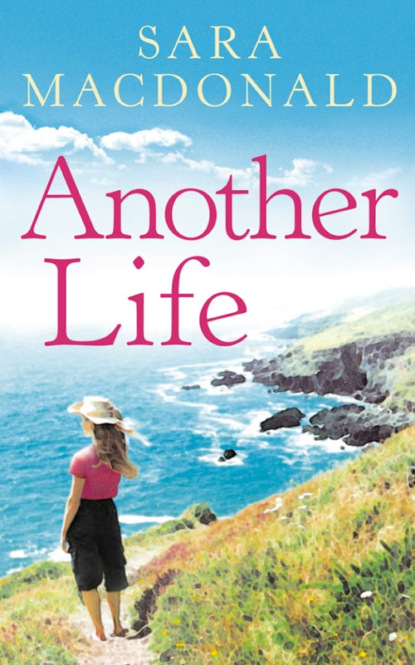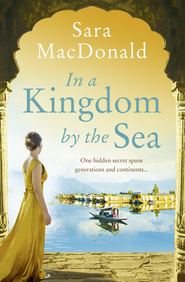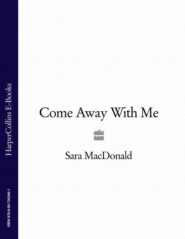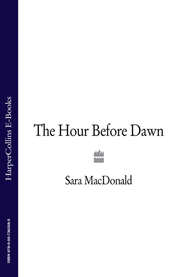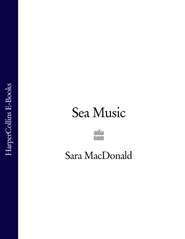По всем вопросам обращайтесь на: info@litportal.ru
(©) 2003-2024.
✖
Another Life: Escape to Cornwall with this gripping, emotional, page-turning read
Настройки чтения
Размер шрифта
Высота строк
Поля
The Canadian, watching her, said softly, ‘Meet Lady Isabella.’
Gabrielle was unable to keep the thrill out of her voice; ‘She is exquisite.’
Mark Hannah laughed. ‘She is, isn’t she.’
‘Where on earth did you find her?’ Gabby asked.
‘Pure chance. I was in Newfoundland giving a series of lectures at the Marine Institute of Memorial University. I had a couple of days there and I decided to go walking. I suddenly spotted her in a garden in Bonavista Bay, among the usual flotsam brought up from the sea. She was wedged between two trees.
‘I knocked on the door and the man who lived there told me she had been given to him as part of a debt owed by his brother-in-law who had once lived in Malpeque Bay, Prince Edward Island. He thought she had been exhibited at some time, maybe at the Green Park Shipbuilding Museum on the west side of Malpeque Bay. I could see a crude attempt to restore her had been made but she was beginning to deteriorate and I asked if he would be willing to sell her to me.’
The boy from the Western Morning News was scribbling fast into his notebook.
‘After a lot of haggling I bought her for the sum of the whole debt owed to him. I told myself I wanted her because I thought she would make an excellent research project for some of my students, but it was love at first sight. I had to have her.’
Gabby, watching him, thought, He must have told this story many times and yet the excitement of the discovery is still with him.
‘I wonder how long she was exposed to the elements,’ she said, looking at the wood-rot and damage at her base.
‘The man told me he had kept her in his old boat shed and had only put her in his garden when he needed his shed.’
Peter Fletcher touched Gabby’s arm. ‘Thanks to Mark’s detective work I was able to trace the original plans for the schooner Lady Isabella. They were in the marine archives in Devon. She was a two-masted ship, commissioned by a wealthy master mariner, an ex-naval gentleman called Sir Richard Magor whose family were big in shipbuilding here in Cornwall and Devon, as well as Prince Edward Island.’
Gabby felt a surge of excitement. ‘Do you have the name of the man who carved the figurehead?’
Peter grinned at her. ‘Oh yes. His name was Tom Welland. He was quite a famous woodcarver in his day. His figures were unmistakable.’
Gabby turned back to the figurehead. She longed to touch that frail face, but knew she must not. The Canadian came to stand beside her.
‘Tom Welland went in for detail. Not all figurehead carvers did, many were quite primitive. He became well-known, not just in England but on the continent as well as Canada and America. He was an artist and was able to pick and choose his commissions. He appears to have travelled widely when he was young, probably as crew on the trading vessels, because traces of his work can still be found in Mediterranean ports. Then he just seems to have stopped carving. No one knows what happened to him. John tells me his family lived and worked around St Piran all their lives.’
‘They did indeed,’ John Bradbury said. ‘Most of them are buried here, but not Tom.’
‘It’s wonderful to have a date. It means we know exactly when she was carved and what materials they would have used,’ Gabby said.
‘But how did you connect her to Cornwall?’ Tristan from the Western Morning News asked Mark Hannah.
The Canadian smiled at the boy. ‘I knew she must be European, possibly British from a trade schooner. The nearest we have to your schooners or barques are Boston trawlers, and the figureheads differ. I went to the public archives. Prince Edward Island was once a British colony and there had been a thriving shipbuilding business between the island and the West Country in the nineteenth century.
‘I couldn’t find any sign of a trading ship called Lady Isabella registered as being built on the island, but records get destroyed or go missing and when I turned to the register of wrecks it jumped out at me. A schooner, the Lady Isabella, lost in a storm in 1867 off Bonavista Bay. Instinct told me this was her. There was no mention of the schooner carrying a figurehead, so I asked an English colleague to check for me in the Lloyds List, London, and there she was, listed and described with figurehead alongside the date of her sinking.’
Peter Fletcher took up the story again. ‘Thanks to Mark’s detective work we looked at the most probable Cornish owners and builders of that period. I went to the Public Record Office to look down the Lloyds Register. Trading vessels had to be registered to get an insurance certificate.
‘I found that a schooner called Lady Isabella, built in Prince Edward Island in 1863 had been granted an A1 certificate of seaworthiness by Lloyds London in 1864. Then I went to the Guildhall Library, where Mark’s colleague had already looked, to double-check the Lloyds List. This also stated that Lady Isabella was wrecked off Newfoundland with all hands in 1867. By that time she was owned by a Daniel Vyvyan, but it was common for ships to be sold on when tonnage was profitable.’
‘So,’ Gabby asked, ‘was this Isabella, Sir Richard Magor’s wife?’
John Bradbury said, ‘We don’t know, bit of a mystery there. Peter and I have been going through the old parish records. The Magors were not from the parish of St Piran, they were an old Falmouth seafaring family and many of them were master mariners. Sir Richard lived in Botallick House, now owned by the National Trust in the parish of Mylor. In the Mylor parish register there is no record of him marrying in the 1860s. None at all.’
‘What about this Daniel Vyvyan guy, who owned her when she sank?’ Tristan asked.
‘The Vyvyan family have lived in St Piran for generations. They owned the mausoleum-like house you see on your right as you come into St Piran. It was Perannose Manor and is now a Christian conference centre. Daniel had two wives, a Helena Vyvyan, née Viscaria, and a Charlotte, née Flemming; both are buried with Vyvyan in the family crypt.’
‘What about daughters?’ Gabby asked.
‘Ah, I was coming to that. Helena and Daniel had a daughter Isabella in 1846 …’
‘What?’ Everybody looked at John Bradbury.
He laughed. ‘I have more! I was talking to a long-retired vicar of Mylor, a bit of an amateur historian and sleuth. He maintains there was an Isabella who was the first wife of Sir Richard Magor. No one knows what happened to her, she is not buried in Mylor or here in St Piran. Legend has it that a page in the parish records registering a marriage in 1864, containing that of Magor and Isabella Vyvyan was torn out, destroyed shortly after that marriage …’
‘Maybe that’s why Richard Magor sold the ship to Isabella’s father, if she had fallen out of favour,’ Gabby said.
‘Quite possibly,’ Peter said. ‘And of course our research is ongoing. What we do know is that in the years the Lady Isabella was built, St Piran had a thriving boat-building business employing many men in the area.’
‘This is all very interesting indeed,’ Councillor Rowe said, ‘but the business of the morning is who is going to restore the figurehead now she is here. The rest we can look forward to hearing later.’
They all stared at him. How on earth could he not be interested in a piece of history that he was hoping to raise money for, Gabby wondered.
‘Quite right!’ Mark Hannah looked as if he was having trouble not laughing. ‘The business of the day.’
They turned back to the figurehead. Mark Hannah said to Gabby, ‘One of the reasons Tom Welland became so well-known and sought after was that sailors believed his carvings were blessed because his faces always looked so alive.’
‘It’s true,’ Gabby said. ‘Her face is disturbingly alive. It’s the eyes, I think.’
‘Mark has offered to go on researching the history of the Lady Isabella for us in London, when he has time between his lecturing engagements and writing his book, and we’re very grateful. Of course, we will go on delving this end too, and hopefully we will discover more about the schooner. We do have a great deal to thank you for, Mark,’ Peter said.
‘Indeed we do,’ John Bradbury agreed, looking pointedly at Councillor Rowe.
Councillor Rowe cleared his throat. ‘London is where I think this valuable piece of local history should be restored. We need a London expert. It is only right and proper that we have the best we can afford.’
Gabrielle knew she was being rebuffed and the councillor wanted to ease her out, but she was not going to give him the satisfaction of seeing that she suddenly felt unsure of her credibility; for it was true, she had never restored a figurehead. She felt the Canadian’s eyes on her, but when she looked up she knew instantly he was rooting for her.
He said in his soft drawl, turning to Rowe, ‘I’ve heard excellent accounts and seen for myself some of Gabrielle’s work. Peter took me to the church of Saint Hilary to see the panels and the two painted wood sculptures Gabriella restored. I also drove to Lanreath to see the painted medieval oak rood-screens she worked on. I can see no good reason for this figurehead being lugged to London if it can be restored professionally here. What do you think, Peter?’
‘I have no doubt whatsoever that Gabrielle is more than qualified to do the job. I’ve worked closely with her before and I’m sure she will do it justice. She’s been working with Nell Appleby, who is one of the best fine art conservators in the county.’
He turned to the councillor. ‘I’m sure you must remember the two major sculptures that Nell and Gabrielle restored about two years ago, Rowe? The seventeenth-century Spanish gilded wood carving of Saint Joseph; and the one of Saint Ann, probably fourteenth-century? It was Gabrielle who found the fragments of original paint.’
Gabby turned away from the men to the wistful wooden face, to the shaved and battered bodice, to the carved fingers with the arms held down close to her body so she could fly through the water.
‘I know you will need to do a proper inspection, Gabrielle, but is it possible to give us a quick assessment?’ she heard Peter ask behind her.
Gabby got out her magnifying glasses and knelt beside the figurehead, bending close, careful not to touch any of the painted sections. She talked the group of men through the various methods she would use, the tests she would carry out before she started. As she talked and examined the face, the cheekbones looked suddenly warm and smooth, and as Gabby’s fingers hovered over her face a strange feeling of familiarity flooded through her as if she was bending to the face of someone she knew well. She wished Nell had come, the detail was breathtaking.
‘The work in this …’ Gabby marvelled as she examined an eyelid, the relaxed and languid lips, ‘… is such a labour of love. She must have seemed so alive and vivid in her once blue dress with the water rushing past her.’
The Canadian’s expression was intent, as if he needed to gauge Gabby’s feelings and the care she would take with his beloved figurehead.





